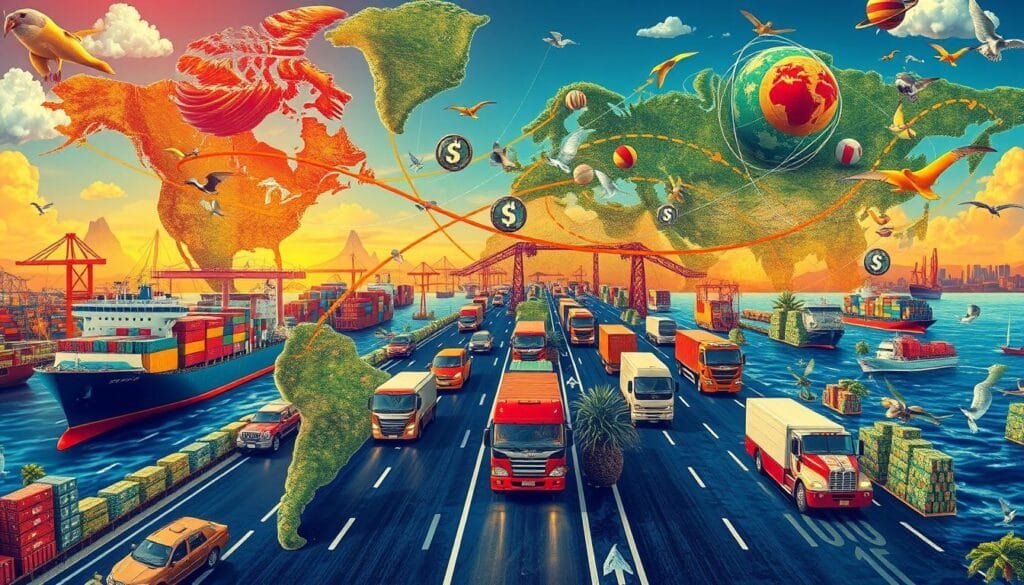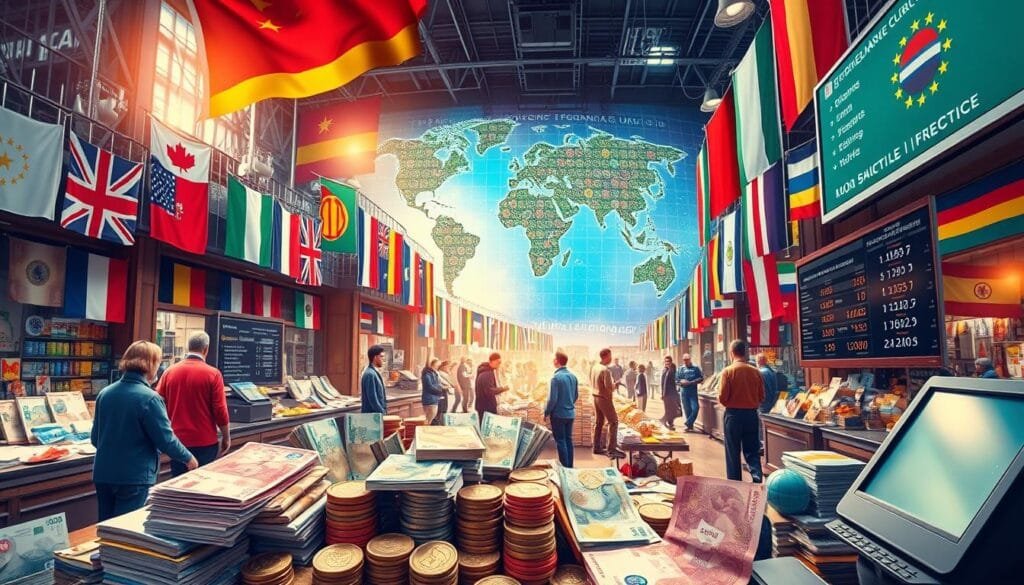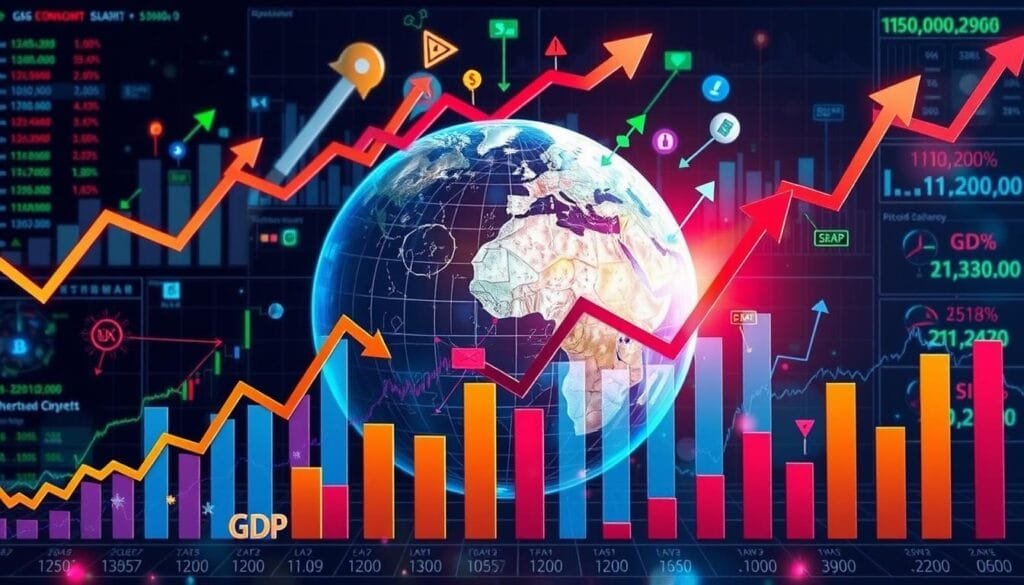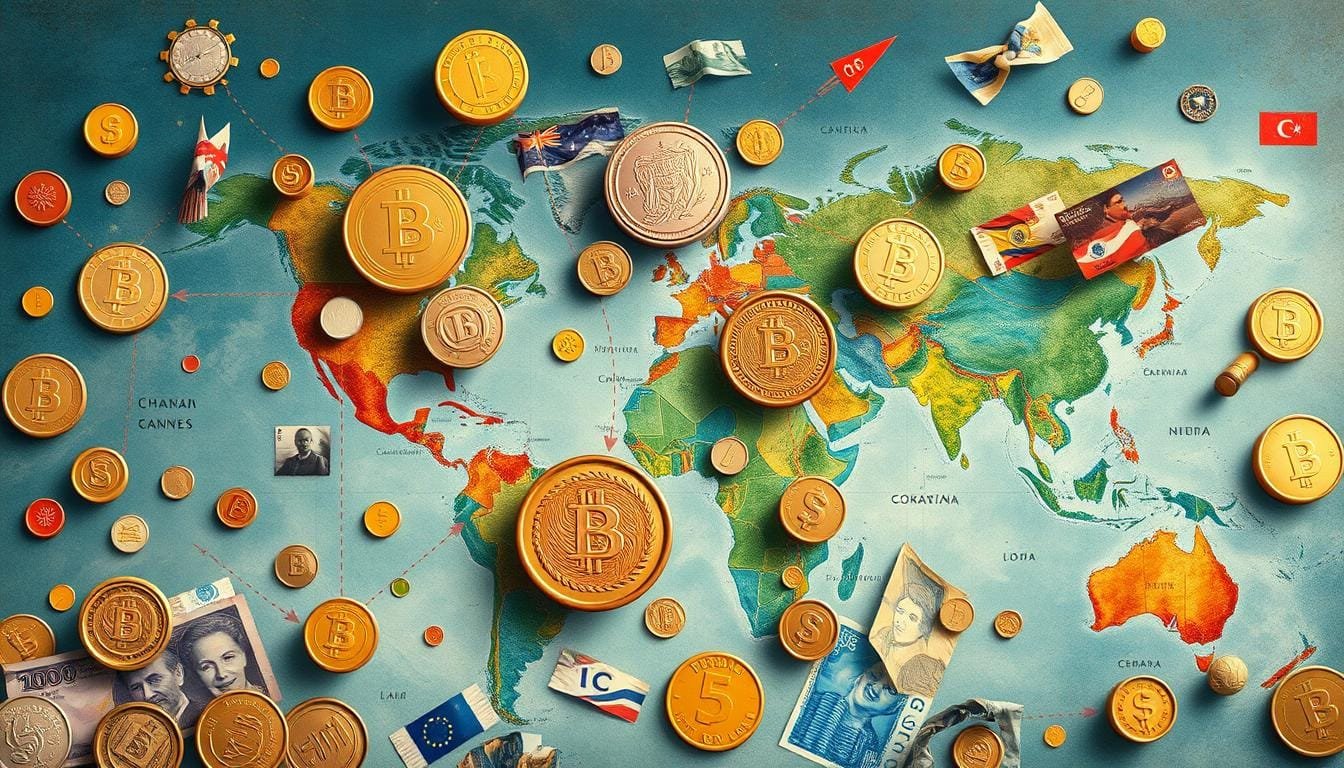How does the exchange rate between the U.S. dollar and the euro affect our spending abroad? It also influences the global economy. Currency exchange is crucial to our lives and the world’s finances. Let’s explore the basics of currency exchange and its vital role in the economy.
Currency exchange is key to foreign exchange principles. It helps markets run smoothly and international trade to function. By learning how exchange rates work and what affects them, we get a clearer picture of its complexity. For instance, did you know airports charge more for changing money? Or that big changes in rates can affect tourism and investments?
One interesting part of currency exchange is how it makes money through bid-ask spreads. In retail forex, the buying price for EUR might be USD 1.30, while the selling price could be USD 1.40. This gap lets currency exchanges profit. If someone buys EUR 5,000 at USD 1.40, it costs USD 7,000. Selling it at USD 1.30 gets USD 6,500, earning the exchange a USD 500 profit. This shows currency exchange’s role in economic trade.
Before July 2020, Cuba charged a 10% tax on converting U.S. dollars to Cuban pesos (CUC). This is an example of how government rules can change exchange rates. Rates also move based on supply and demand for goods, changing hourly. It’s key to know foreign exchange principles for dealing with global finance.
Key Takeaways
- The bid-ask spread is a critical way currency exchanges earn profits.
- Exchange rates at airports tend to be higher due to convenience factors.
- Government policies can significantly influence currency exchange rates.
- Daily fluctuations in exchange rates affect supply and demand for international goods.
- Understanding currency exchange mechanisms helps in global financial stability.
What Is an Exchange Rate?
Exchange rates are vital for global economic activities. They define the value of one currency compared to another. This affects trade, tourism, and financial status across countries. Let’s explore what exchange rates mean, their importance, and the different types.
Definition and Importance of Exchange Rates
An exchange rate is the cost of one currency in another’s terms. It is crucial in global finance. It influences imported goods’ prices and the success of export companies. For example, 1 AUD equals about 0.75 USD. These rates affect foreign investments and savings too.
Foreign exchange rates also sway inflation and interest rates, shaping economic wellness. Central banks often work to keep inflation under 2% annually. Exchange rates play a big part in achieving this goal.
Types of Exchange Rates
There are mainly two kinds of exchange rates: fixed and floating.
Fixed rates mean a currency sticks to another major currency like the US dollar. For instance, the Saudi riyal is tied to the US dollar at around 3.75 SAR for 1 USD. The Danish krone is set to the euro, allowing slight changes within specific limits.
On the other hand, floating exchange rates move with market supply and demand. Since 1983, Australia’s currency value changes based on market trends. Floating rates can shift often because they respond to current economic situations and forecasts. The forex trading market is a place where these fluctuations are noticeable daily.
The Trade-Weighted Index (TWI) shows a currency’s rate against a selection of others. It helps understand exchange rates on a wide scale.
In conclusion, exchange rates are essential in the global economy. They guide the movement of goods, services, and money internationally. With the forex market’s ups and downs, both floating and fixed rates deeply influence countries’ economic decisions and strategies.
How Do Exchange Rates Affect the Global Economy?
Exchange rates play a key role in the world’s economy. They impact international trade, inflation, and interest rates. Changes in these rates can majorly shift economic growth worldwide.
Impact on International Trade
If a country’s currency strengthens, its products become pricier abroad, leading to potential drops in exports. In contrast, a weaker currency makes imports more expensive, causing “imported” inflation. For example, a country’s currency falling by 20% might raise import costs by 25%.
When the Japanese yen rose by over 25% against the U.S. dollar, its exports suffered. This happened between August 2008 and January 2009. It greatly affected Japan’s economy that relies heavily on exports.

However, a 16% fall in the yen, due to Abenomics in 2013, improved Japan’s competitive edge globally but made imports more expensive. The euro also dropped 20% against the dollar from December 2009 to June 2010, amid EU debt concerns. These cases show how currency values deeply influence global trade.
Influence on Inflation and Interest Rates
Exchange rates significantly affect inflation. Countries like Japan, Germany, and Switzerland saw their currencies appreciate due to low inflation, which made their imports cheaper and exports costlier. But when a currency depreciates, the price of imports goes up, leading to higher inflation.
Interest rates are also tied to exchange rates. Higher interest rates draw foreign investment, boosting the currency. Central banks, such as the Bank of England or the U.S. Federal Open Market Committee, adjust rates to steer the economy. But, this strategy can backfire if inflation outruns that of other countries, weakening the currency’s benefit.
| Country | Exchange Rate (1 USD) | Inflation Rate | Interest Rate |
|---|---|---|---|
| Japan (JPY) | 145.0 | 0.2% | -0.1% |
| Germany (EUR) | 0.85 | 1.4% | -0.5% |
| United States (USD) | 1.00 | 2.1% | 1.5% |
Understanding how exchange rates, global trade, inflation, and interest rates connect shows the complexity of our economies. Changes in one area can affect many others across the globe. This creates a complex web of economic interactions.
What Is Currency Exchange in Economics?
Currency exchange is vital in global trade. It affects economies locally and globally. It involves people, companies, and governments swapping currencies for international business, investments, and travel. Knowing currency exchange fundamentals helps us understand its economic impact.
When we travel abroad, we exchange our money for the local currency. Businesses operating globally must also deal with changing exchange rates. This affects their costs and how much profit they make.

The forex market is where currency trading happens online, 24/7. Online platforms and apps have made trading easier and more accessible. They offer good rates, drawing in more users. Forex brokers provide important market insights and support large transactions, useful for investors and companies.
Currency exchange is not just for tourists and traders. It’s also key in international finance. For example, when InBev bought Anheuser-Busch for $52 billion in 2008, a big currency exchange was needed for the deal.
Various factors influence exchange rates. These include economic stability, political events, and market speculation. For instance:
- A weak currency might lower export prices but raise import costs.
- A strong currency may increase export prices but reduce import costs.
- High interest rates often draw foreign investment, raising the currency’s value.
- Economic indicators, like growth and jobs, affect currency demand.
- Political stability tends to increase foreign investment and strengthen the currency.
Exchanging currency comes with fees and a ‘spread’ between buying and selling rates. Costs can differ between physical and online exchanges. In today’s economy, with $5.3 trillion traded daily in forex, understanding currency exchange fundamentals is key. It’s vital for managing travel finance and international investments properly.
Factors That Influence Exchange Rates
It’s important to know what affects exchange rates if you’re in the forex market. Both economic indicators and supply and demand dynamics are key. They greatly influence how currencies are valued around the world.
Economic Indicators
Economic indicators deeply impact exchange rates. Vital indicators like GDP growth, unemployment rates, and trade relations shape a currency’s strength. For example, countries with low inflation usually have stronger currencies.
Central banks adjust interest rates to control inflation. Higher interest rates draw in foreign capital, making the local currency stronger. On the other hand, high government debt can reduce a currency’s value by causing inflation and deterring investment.
- Low inflation = Stronger currency; high inflation = Weaker currency
- High interest rates attract foreign capital, appreciating local currency
- Excessive government debt can devalue the currency
- Political stability, such as in Switzerland, attracts foreign investment, strengthening the currency
- Low unemployment rates generally enhance consumer spending and foreign investment, bolstering currency values
- Positive balance of trade increases foreign currency inflow, boosting local currency
Market confidence and speculation also matter a lot. For instance, fear of a bad election outcome can quickly lower a currency’s value.

Supply and Demand
The supply and demand laws significantly decide exchange rates. Strong economies and smart policies make a currency more desirable, upping its value. A recession, however, can reduce its value due to lower interest rates.
Positive feelings in the market lift a currency’s value. Negative views do the opposite.
| Factors | Impact on Currency |
|---|---|
| High interest rates | Appreciates currency by attracting foreign capital |
| Increased government debt | Devalues currency by driving up inflation |
| Political stability | Strengthens currency by attracting investment |
| Positive balance of trade | Enhances currency value through higher foreign currency inflow |
| Low unemployment rates | Boosts consumer spending and foreign investment, strengthening the currency |
| Market confidence | Increases currency value |
| Recession | Depreciates currency due to lower interest rates |
Geopolitical stability invites foreign investment, appreciating the currency. However, geopolitical risks can decrease its value. To manage risks, countries and companies use Forward Contracts and Limit Orders. These lock in future exchange rates. Governments might also adjust interest rates or participate in forex to stabilize their currencies.
Knowing these factors is key to understanding the forex market. Economic indicators and supply and demand insights help us grasp currency fluctuations. By staying informed, we can predict and react to global financial changes better.
Conclusion
When we look into currency exchange, we see its big impact on the global economy. It affects trade balances and the inflation and interest rates. Knowing how these work is key for making good economic strategies.
The FX market is huge, moving $7.5 trillion every day in 2022. Its effect on money matters is clear. People and businesses get ahead by understanding the top trading pairs like EUR/USD, USD/JPY, and GBP/USD. This market works all day and night, showing its wide reach.
Moving away from the gold standard in 1973 changed things a lot. It made economies more flexible. Also, pros using arbitrage and carry trade show the smart ways to handle this market. Looking at the financial insights we’ve gotten, it’s obvious. Good currency exchange is vital for keeping the world’s economy stable and growing.
FAQ
What is the fundamental concept of currency exchange in global economics?
Currency exchange lets us swap one currency for another. It helps global trade, investment, or travel. This is key for global economic health. It helps with transactions everywhere, affecting finance and economic stability worldwide.
What is an exchange rate?
An exchange rate shows how much one currency is worth in another. It’s essential for world trade and finance. This rate determines how much we can swap currencies, influencing tourism and prices.
What are the types of exchange rates?
There are two main types: floating and fixed exchange rates. Market forces set floating rates. Fixed rates are tied to another major currency. Both types are overseen by governments and financial bodies.
How do exchange rates affect the global economy?
Exchange rates impact global trade, inflation, and interest rates. They can change prices for imports and exports, tweaking trade balances. This also affects countries’ monetary policies and financial health.
What role do exchange rates play in international trade?
They are key for global trade, affecting costs of exports and imports. Good exchange rates make exports affordable and competitive. Bad rates can make imports pricier, changing trade balances and economies.
How do exchange rates influence inflation and interest rates?
They can make imported goods more or less expensive. This changes price levels at home. Central banks might adjust rates to manage the economy and keep prices stable.
What is the significance of currency exchange for individuals and businesses?
It’s crucial for anyone involved in international dealings. It makes swapping currencies easy for business, travel, and investment. This affects everything from vacation budgets to global business and investing.
Which economic indicators influence exchange rates?
GDP growth, unemployment rates, and trade relationships are important. They show a country’s economic health. This can make its currency stronger or weaker on the forex market.
How do supply and demand affect exchange rates?
Supply and demand laws are vital. High demand boosts a currency’s value. Low demand lowers it. Things like policies and global events can change these dynamics.
